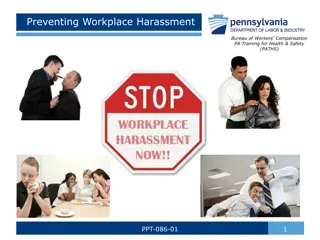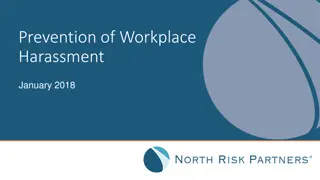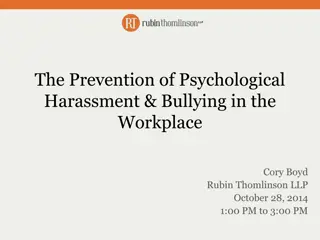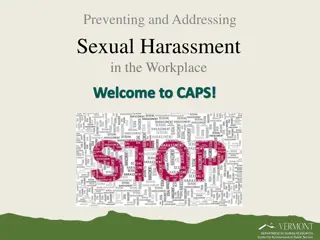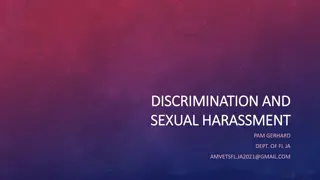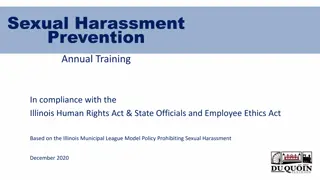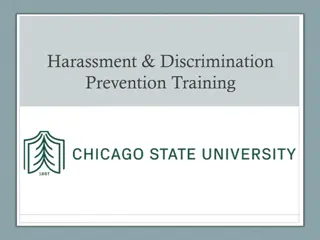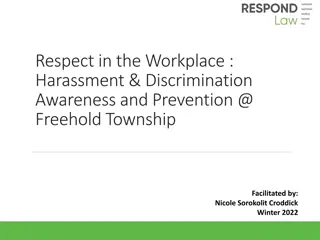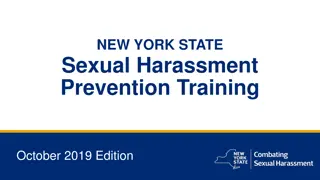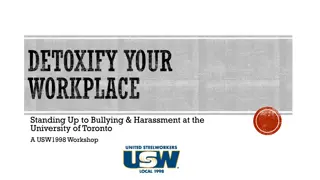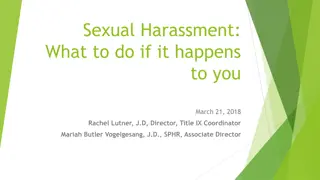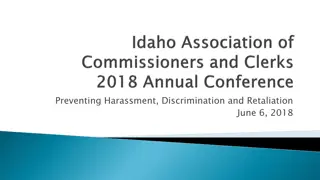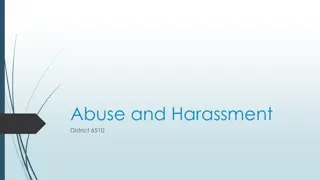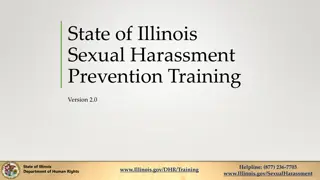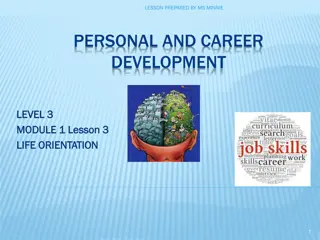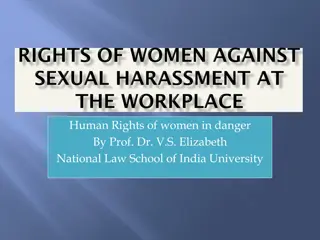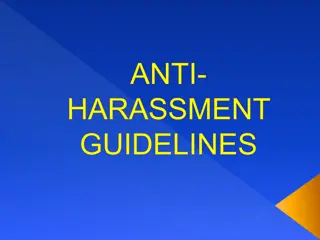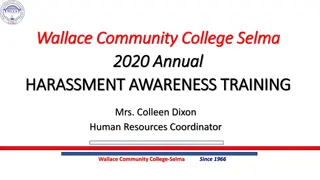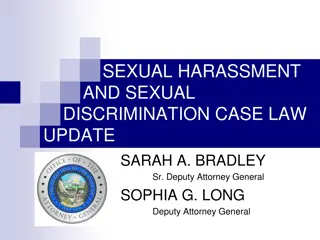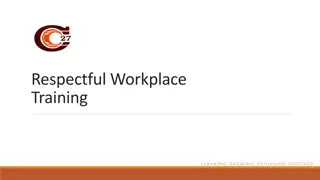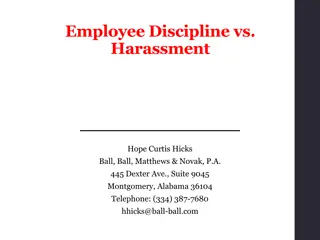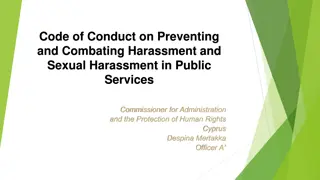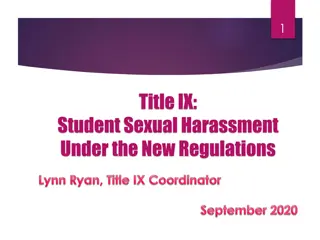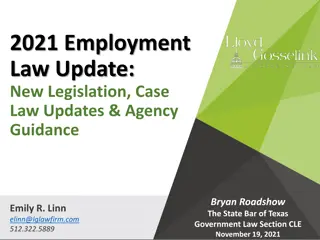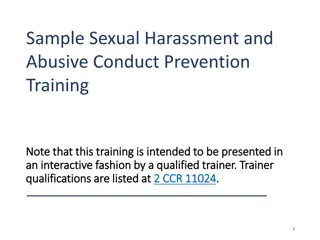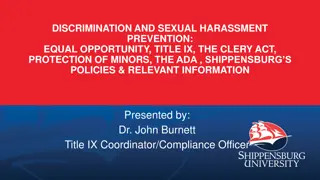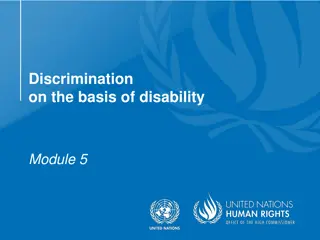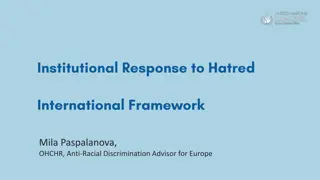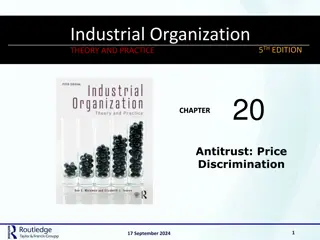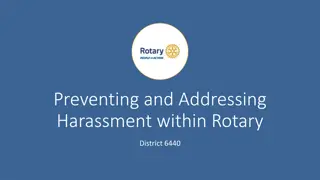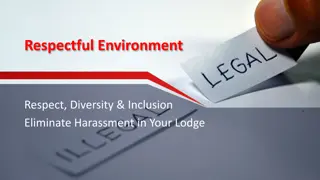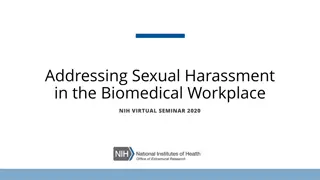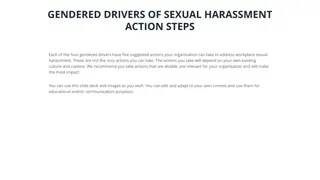Understanding Harassment and Discrimination in the Workplace at Marion Military Institute
The workplace at Marion Military Institute is not immune to the potential for harassment and discrimination, including sexual harassment. These types of behavior can lead to low morale, absenteeism, reduced productivity, and high employee turnover. It is crucial to define and recognize different forms of harassment, know how to identify them in the workplace, and understand the process of filing a complaint.
Download Presentation

Please find below an Image/Link to download the presentation.
The content on the website is provided AS IS for your information and personal use only. It may not be sold, licensed, or shared on other websites without obtaining consent from the author. Download presentation by click this link. If you encounter any issues during the download, it is possible that the publisher has removed the file from their server.
E N D
Presentation Transcript
Harassment and Discrimination In The Workplace Marion Military Institute Human Resources Mrs. Carmon Fields Title IX Coordinator/Director of Human Resources
Introduction The potential for harassment, including sexual harassment and discrimination, exists in every workplace. Harassment and discrimination of any kind can result in low morale, absenteeism, reduced productivity, employee turnover, etc.
Learning Objectives Define harassment and sexual harassment Know the different types of harassment. Identify harassment in the workplace. Know how to file a complaint.
Definition of Sexual Harassment Sexual Harassment is the conduct on the basis of sex that satisfies one or more of the following: A school employee conditioning education benefits on participating in unwelcome sexual conduct (i.e. quid pro quo); Unwelcomed conduct that a reasonable person would determine is so severe, pervasive, and objectively offensive that if effectively denies a person equal access to the school s education program or activity; or Stalking, dating violence, or domestic violence.
Definition of Harassment Harassment is the striking, shoving, kicking, or otherwise touching or making physical contact in regard to another to the purpose of harassing, annoying or alarming; and/or directing abusive or obscene language or making an obscene gesture toward someone for the purpose of harassing, annoying, or alarming. Example: Making or using persistent derogatory comments, epithets, or slurs that place a person in a hostile or fearful environment or where the person s safety is in jeopardy.
Basic types of Unlawful Harassment Quid Pro Quo- This for That Hostile Work Environment Harassment Stalking, dating violence, domestic violence or sexual assault
Quid Pro Quo Harassment- This for That Quid pro quo harassment generally results in a tangible employment decision based upon the employee s acceptance or rejection of unwelcome sexual advances or requests for sexual favors, and other verbal or physical conduct of a sexual nature, by a person having power or authority over another constitutes sexual harassment when submission to such sexual conduct is made either explicitly or implicity a term of condition of rating or evaluating an individual s educational or employment progress, development, or performance. This kind of harassment is generally committed by someone who can effectively make or recommend formal employment decisions (such as termination, demotion, or denial of promotion) that will affect the victim. Examples: Supervisor who fires or denies promotion to a subordinate for refusing to be sexually cooperative; Supervisor requires a subordinate to participate in religious activities as a condition of employment; Supervisor offers preferential treatment/promotion if subordinate sexually cooperates or joins supervisor s religion.
Hostile Work Environment Harassment A hostile work environment can result from the unwelcome conduct of supervisors, co-workers, customers, contractors, or anyone else with whom the victim interacts on the job, and the unwelcome conduct is determined by a reasonable person to be so severe, pervasive, and objectively offensive that it effectively denies a person equal access to the recipient s education program or activity. Examples of behaviors that may contribute to an unlawful hostile environment include: Discussing sexual activities; Telling off-color jokes concerning race, sex, disability, or other protected bases; Unnecessary touching; Commenting on physical attributes; Displaying sexually suggestive or racially insensitive pictures; Using demeaning or inappropriate terms or epithets; Using indecent gestures; Using crude language; Sabotaging the victim s work; Engaging in hostile physical conduct.
Stalking Engaging in a course of conduct directed at a specific person that would cause a reasonable person to a)fear for his or her safety or the safety of others; or b)suffer substantial emotional distress. In Alabama, stalking is when a person intentionally and repeatedly follows or harasses another person and who makes threat, either expressed or implied, with the intent to place that person in reasonable fear of death or serious bodily harm (13A-6-90 Stalking 1st degree) or a person who, acting with an improper purpose, intentionally and repeatedly follows, harasses, telephones, or initiates communication, verbally, electronically, or otherwise, with another person, any member of the person s immediate family, or any third party with whom the other person is acquainted, and causes material harm to the mental or emotional health of the other person, or causes such person to reasonably fear that his or her employment, business, or career is threatened, and the perpetrator was previously informed to cease that conduct (13A-6-91 Stalking 2nd)
Dating Violence Means violence committed by a person (a) Who is or has been in a social relationship of a romantic or intimate nature with the victim; and (b) Where the existence of such a relationship will be determined based on a consideration of the following factors: 1. The length of the relationship; 2. The type of relationship; 3. The frequency of interaction between the persons involved in the relationship.
Domestic Violence Includes felony or misdemeanor crimes of violence committed by a current or former spouse of the victim, by a person with whom the victim shares a child in common, by a person cohabitating with or has cohabitated with the victim as a spouse, or by any other person against an adult or youth victim who is protected from that person s acts under the domestic or family violence laws of the jurisdiction. In Alabama, domestic violence includes felony and misdemeanor crimes of violence committed by a current or former spouse, parent, child, any person with whom the defendant has a child in common, a present or former household member, or a person who has or had a dating or engagement relationship with the defendant.
Sexual Assault An offense classified as a forcible or non-forcible sex offense under the uniform crime reporting systems of the Federal Bureau of Investigation.
EXAMPLES OF HARASSMENT Quid Pro Quo This for That The supervisor in this photo gives an unexpected Thank You to her subordinate after he completes a report that she is responsible for. She tells him that if you keep this up, you will get that promotion that you have been wanting.
Inappropriate Touching/Invading Personal Space EXAMPLES OF HARASSMENT The people in this photo are co-workers of the same status. Paul frequently compliments Amy on her appearance. She has never objected to his compliments but the touching makes her uncomfortable.
Bullying and Intimidation EXAMPLES OF HARASSMENT Jim is a recent college graduate and was just hired; he really needs this job. His boss, Alex, is the President of the company and believes that the younger generation does not work as hard as baby boomers . Jim likes technology and used his skills to shorten the steps in completing a weekly report. Alex does not like change and this photo above shows his reaction when Jim presented the report.
Inappropriate Communication in the Workplace Are you at Risk? EXAMPLES OF HARASSMENT Patty is at work when she receives another e-mail with explicit photos from her friend Debra who also works at the college. She is so amused that she decides to send it to Sharon, even though Sharon has asked her to stop sending non work related emails. Sharon is horrified ....but, Patty thinks that this is harmless and believes that surely Sharon would enjoy the photos as much as she did.
Gossiping about Co-Workers EXAMPLES OF HARASSMENT Mike is sharing some juicy gossip about Katie and Eric with his friends. Katie s friend Nancy overhears the conversation and tells her what was said. Katie s Reaction . Katie insists that the rumors are not true but she is embarrassed and does not want to work here anymore.
Harassment and discrimination is disrespectful, against company policy and can be illegal. I am who I am. Some of us do not mean any harm and we are just being who we are, but, if someone views our comments, gestures or e-mails as offensive we have put ourselves and possible others in jeopardy. We can greatly decrease or prevent possible harassment charges against us by doing two simple things . Filter our language and actions at work.
To File a Sexual Harassment Complaint: Any individual may report a sexual harassment incident to the Title IX Coordinator in person, by email, by telephone, or in writing. The report must include the name(s) of the Complainant(s) and Respondent(s), approximate date of incident, facts of the incident, and contact information for the person submitting the complaint. The Title IX Coordinator will respond in writing to the person submitting the complaint as soon as practicable, but not exceeding five (5) business days. If the person submitting the complaint is not the Complainant, the Title IX Coordinator will also contact the Complainant within five (5) business days. If after a discussion with the Complainant, the Title IX Coordinator determines that the complaint does not qualify as a Title IX Complaint, the Title IX Coordinator will notify the Complainant in writing and may redirect the Complaint to the appropriate . BE THE SOLUTION!!
To File a Sexual Harassment Complaint Cont. Committee. If after discussion between the Complainant and the Title IX Coordinator, the Title IX Coordinator determines that the complaint meets the criteria of a Title IX Complaint and the Complainant requests to file a formal complaint, the Title IX Coordinator will initiate the formal complaint process. Let s work together to prevent Discrimination and Harassment in the workplace.
Dismissal of Formal Complaint The College may dismiss a formal complaint or allegations if: The Complainant informs the Title IX Coordinator in writing that the Complainant desires to withdraw the formal complaint or allegations therein, The Respondent is no longer enrolled or employed by the school, or Specific circumstances prevent the school gathering sufficient evidence to reach a determination. The College must dismiss a formal complaint or allegation if: The allegations do not meet the definitions of sexual harassment The alleged conduct did not occur within the United States, or The alleged conduct did not occur within a College sponsored program or activity.
Dismissal of Formal Complaint (cont.) If the College determines the formal complaint or allegations therein will be dismissed, the Title IX Coordinator will provide written notice to both parties of the dismissal of allegations, the reason for dismissal within five (5) business days of the decision to dismiss the complaint and the Complainant s right to Appeal, if applicable.


